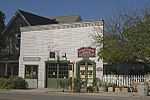Zaca Oil Field

The Zaca Oil Field is an oil field in central Santa Barbara County, California, about 20 miles southeast of Santa Maria. One of several oil fields in the county which produce heavy oil from the Monterey Formation, the field is hidden within a region of rolling hills, north of the Santa Ynez Valley. As of 2011, the principal operator of the oil field is Greka Energy and the operator of the "Zaca Field Extension Project" is Underground Energy. The field is known to contain heavy crude oil and Underground Energy has recently discovered a lower sub-thrust block in the field, which was not previously produced by the field's historical operators. The field was discovered in 1942, reached peak production in 1954, and remains active with more than thirty oil wells and continues to grow.
Excerpt from the Wikipedia article Zaca Oil Field (License: CC BY-SA 3.0, Authors, Images).Zaca Oil Field
Geographical coordinates (GPS) Address Nearby Places Show on map
Geographical coordinates (GPS)
| Latitude | Longitude |
|---|---|
| N 34.7245 ° | E -120.1448 ° |
Address
Rancho Corral de Quati
93441
California, United States
Open on Google Maps




